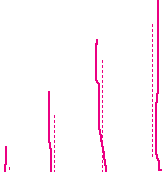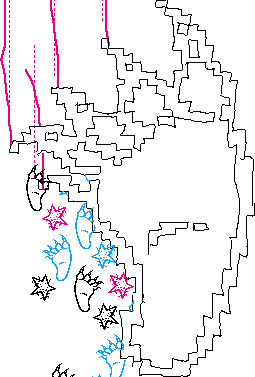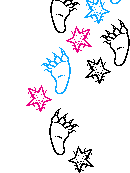| (1) GENERATION FLASH (2) FAQ (3) UTOPIA IN SOFWARE (4) THE UNBEARABLE LIGHTNESS OF FLASH (5) ART, MEDIA AND SOFTWARE ART (6) POSTSCRIPT LEV MANOVICH, 2002 (7) WEBSITES, THE ART OF OUR TIMES MILTOS MANETAS , 2002 (8) FLASH IS POPTECH PETER LUNENFELD, 2001
Generation FLASH: FAQ by Lev Manovich
After I posted the preceding segments on popular mailing lists dealing with new media art and cyberculture (rhizome.org and nettime.org), I received lots of responses. Here are my answers to two most commons questions which appeared in a number of responses.
Question: Is not “soft modernism” you describe simply a result of particular technological limitations of multimedia on the Net? You seem to mistake the particular features of Flash designed to deliver animation over the narrow bandwidth for a larger zeitgeist.
Answer: Now that the new release of Flash (Flash MX) allows for import and streaming of video, it is possible that soon "Flash generation" / "soft modernism" aesthetics will leave Flash sites. This is fine. My concern in this essay is not with Flash software and its limitations/capabilities per ce, but with the new sensibility that during the last couple of years manifested in many Flash projects. In other words, I am interested in "generation Flash" that is quite different from Flash software/format. Therefore the number of people who after reading my text accused me of confusing a technical standard with aesthetics missed my argument. The vector oriented look of "soft modernism" is not simply a result of narrow bandwidth or a nostalgia for 1960s design - it always happens when people begin to generate graphics through programming and discover that they can use simple equations, etc. This is also why "soft modernism" of Flash projects and other software artists replays, sometimes in amazing detail, the aesthetics of early computer art (1950s-1970s) when people were only able to create images and animations through programming.
Question:
Answer:
So I have nothing software artists using/creating media, but I hope that "Flash generation" will extend its programming work to representational media! In other words, if in the early 1970s the paint program and the animation program were revolutionary in changing people idea about a computer away from computation and towards a (creative) medium, after almost two decades of menu based media manipulation programs and the use of computers as media distribution machine (greatly accelerated by World Wide Web), a little programming can be quite revolutionary! In short, we have now are so used to think of a computer as a "personal dynamic medium," that we need to remind ourselves and others that it is also a programmable machine. Now, think about how programming has been used so far to create/use still images, animation and film/video. There are three trajectories that can be traced historically. One trajectory extends from the earliest works of computer art - the films by the Whitney made with an analog computer already in the mid 1950s (who were the students of Oscar Fishinger and thus represent a direct link with the early twentieth century modernism) - to today's "soft modernism" of Flash projects and data visualization artworks. In other words, this is the use of programming to generate and control abstract images. The second trajectory begins in the 1980s when Hollywood and TV designers started to use computer-generated imagery (CGI). Now, programming was put in the service of traditional cinematic realism. Particle systems, formal grammars, AI and other software techniques became the means to generate flying bats, hilly landscapes, ocean waves, explosions, alien creatures, and other figurative elements integrated in a photorealistic universe of a narrative film. What about using algorithms not simply to generate figurative elements of a narrative but to control the whole fictional universe? This is the third trajectory: programming in computer games (1960-). Here algorithms may control the narrative events, the behavior of characters, camera movement, and other characteristics of the game world - all in real time. Unfortunately, as we all know, aesthetically revolutionary computer and player driven game worlds feature formula-driven content that makes even a bad Hollywood film appear original and inspiring by comparison. (Grand Theft Auto 3 is no exception here - despite its breakthroughs in simulating a more compelling an open universe.) I think this brief survey shows that there is still an untouched space completely open for experimentation and creative research - using programming to generate and/or control figurative/fictional media. For instance, in the case of a movie, programming can be used to generate characters on the fly, to composite in real-time characters shot against a blue screen with backgrounds, to control the sequence of scenes, to apply filters to any scene in real-time, to combine prerecorded scene with on the imagery generated on the fly, to have characters interact with the viewer, etc, etc. In short, programming can be used to control any aspect of a fictional media work. Of course, once in a while one encounters projects moving in this direction at places like SIGGRAPH or ISEA, but they are typically research demos created in Universities that do not reach culture at large. Of course, you can object that having an algorithmically controlled complex fictional universe requires the kind of programming investment only possible in a commercial game company or in a University. After all, this is not the same as writing a script that draws a few lines that keep moving in response to user input...yes, but why our fictional/figurative works have to follow the formulas of commercial media? If one accepts that the characters do not have to be "photorealistic," that the fictional world does not have to be exclusively three-dimensional, that chance and randomness can coexist with narrative logic, or that stick figures can coexist with 3-D characters and video footage, etc., programming figuration / fiction becomes less formidable. In short, while I welcome programming Flash, I think it is much more challenging to program QuickTime.
|
![]()
 |
 |
 |